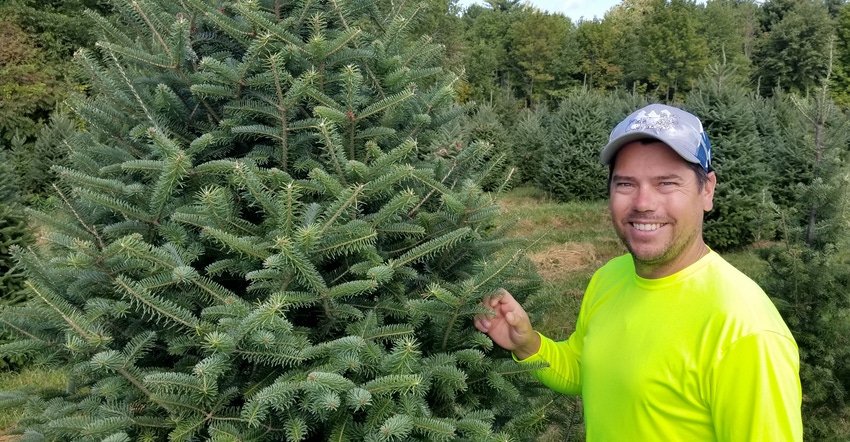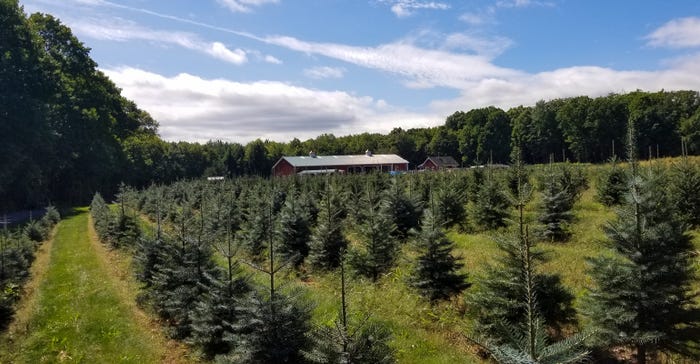October 9, 2020

Christmas trees can offer dairy farmers a way to supplement their farm income or stay in agriculture without the daily demands of caring for large animals.
For Springside Farm owners Ed and Paulie Drexler, the decision was an easy one. They’d been growing trees as a sideline for many years, but at 50, Ed turned to his wife one day said, “We’ve got 25 good years left. What would you like to do with the rest of your life?”
He simply wanted a different lifestyle and more time to focus on trees at their central New York farm near Syracuse.
“Christmas trees don’t jump the fence,” she says, smiling. “Nobody calls you at two in the morning and says, ‘The trees are out!’ If you want to go to a wedding, nobody says you have to mow the trees that day, that kind of thing. You can structure your workload around Christmas trees, so you have quite a bit more freedom of time. With the dairy everything had to be done for the cows. Animals have to be fed every day and we were always involved with fall harvest. You had to get the corn in. It wasn’t until we got rid of the cows that we had more time.
“And the equipment required for trees is much smaller. We do most our mowing with zero-turn lawn mowers.”
The market for live trees is extremely strong right now and growers are more than willing to help newcomers get started.
“It’s a wonderful industry of people,” she says. “There’s a lot of room out there for everybody. My problem isn’t competition from the tree farmer next door. I taught his kids how to make wreaths and roping. It didn’t bother me in the least. He’s not my problem. My problem is the artificial tree.”
Plan for the long term
There’s no time like the present to get started because raising Christmas trees is an extremely long-term proposition.
“There’s actually a shortage of real trees,” she says. “People aren’t growing them because people aren’t patient. They’re perfectly willing to hop on the newest trend like hemp, hops, all that kind of stuff.”

It takes seven to nine years before trees are ready to harvest and with another year dedicated to clearing and planting, land might be tied up for an entire decade.
“As bad as the dairy industry is with milk prices, at least there’s a steady income there,” says Pete Goderie, co-owner of the fifth-generation Goderie’s Tree Farm in Johnstown, N.Y. “When you transition to Christmas trees, unless you’ve got another income, it’s about 10 years before you see an income.”
That’s why, like most growers, Goderie’s farm has a diversity of revenue streams such as a greenhouse operation and contracting business.
Family-owned Springside Farm also has a thriving side fiber business with livestock such as sheep, goats and alpacas in addition to hosting weddings, a summer day camp, autumn corn maze and pick-your-own pumpkin patch.
“We’re an extraordinarily diverse operation, but Christmas trees are the bedrock, the backbone for what we’re doing right now, and Ed enjoys it,” owner Paulie Drexler says. “It keeps you moving, yet at a pace that doesn’t break the bones. It’s not like milking cows where your knees and shoulders give out.”
Long road to profitability
Chip and Sally Ellms founded Ellms Family Farm in 1983 utilizing a former fruit farm they had purchased in Charlton, N.Y. Soon after, they started buying land from a neighboring dairy farmer who was downsizing, and in 2000 they purchased the entire farm.
Today, the Ellms have about 30,000 trees under production and their son, Garth, 38, recently took over the business.
While there are plenty of rewards, Garth, too, cautioned prospective tree farmers to consider things carefully because there is no shortage of challenges such as potential damage from poor weather, insects and deer.
 CONSIDER OPTIONS: Raising Christmas trees can be a rewarding business that produces lots of fond memories for customers who visit farms to cut their own tree. But there are also lots of challenges such as potential damage from weather, insects and deer. Plus the fact that a farmer will usually only generate an income years into the venture.
CONSIDER OPTIONS: Raising Christmas trees can be a rewarding business that produces lots of fond memories for customers who visit farms to cut their own tree. But there are also lots of challenges such as potential damage from weather, insects and deer. Plus the fact that a farmer will usually only generate an income years into the venture.

“You’re constantly monitoring, looking for problems such as bugs,” he says “Last year we had a big root aphid problem. Luckily, we have great resources at Cornell, so we were able to identify and treat it within a day. But you can plan on about 30-percent loss from the day the seedling goes in the ground to the day of harvest.
“If you have all the tractors, the land and everything, that first year you’re probably spending about $3,000 to $4,000 per acre, and maybe a couple thousand each year in fertilizer, sprays and insect pesticide control. Then there’s the cost of infrastructure — roads, buildings and everything else. It’s a lot more than you realize, and trees have to be trimmed twice, every single year.”
Chip Ellms says it took 25 years to become profitable. Fortunately, he had a successful business career to rely on while building his diverse farm venture, which also includes one of the Capital Region’s most popular fall agritourism destinations.
“You need to start thinking about trees before you start thinking about kids if you want to put your kids through college with Christmas trees,” Garth says.
Goderie’s Tree farm was a dairy until Pete Goderie’s great-grandfather sold off his cows and half the farm in 1960.
“In 1970, my father decided to plant Christmas trees with the idea it was going to put me and my brother, Mike, through college,” he says.
The money wound up paying for Pete Goderie’s children’s tuition, not his. In 2000, the family’s agricultural heritage came full circle when Pete and Mike Goderie bought back the land their great-grandfather sold 40 years earlier.
From its original 30 acres, the farm now has 150 acres of trees under production, primarily Fraser fir, one of the industry’s most popular varieties because of its lengthy needle retention.
“But nothing can beat the fragrance of balsam and they’re a little more forgiving, they’ll take a little bit heavier soil,” Pete says. “Fraser fir want to have dry feet; 24 to 48 hours of standing water will kill a mature tree. They want well-drained soil. That’s why site selection is so important. If you want to get into the business take a year or two to evaluate your soils. The one thing everyone thinks initially is, ‘I’ll put the trees on my poorer ground, my poorer soil.’ But trees are like every other crop. The better the ground the better the trees.”
Consider options
Mary Jeanne Packer, executive director of the Christmas Tree Farmers Association of New York, says that she’s gotten quite a few recent inquiries from people who have either bought or inherited a farm, or are looking to add a new crop.
“The best advice I can give is if you’re flexible, consider buying a Christmas tree farm that’s already established,” she says. “It would be an absolutely excellent investment because the hard work has already been done. All you have to do is keep the trees alive, shape them and make a sale.”
Paulie Drexler says there’s almost limitless information available online for getting started.
“In this day and age, a lot people don’t join trade associations and they should,” she says. “Ninety percent of the good tips you get come when you go to their meetings, just chatting around the lunch table. That kind of networking has almost gone out of style with people who think they learn everything they need on YouTube.
"I’m not saying you can’t, but sometimes you don’t know you have a problem or that there’s a solution until you talk to other people. Back before internet, that’s how you learned. It’s still a valid method of exchanging information. It’s a great way to pick up a tip.”
Post writes from eastern New York
Read more about:
Christmas TreesAbout the Author(s)
You May Also Like




